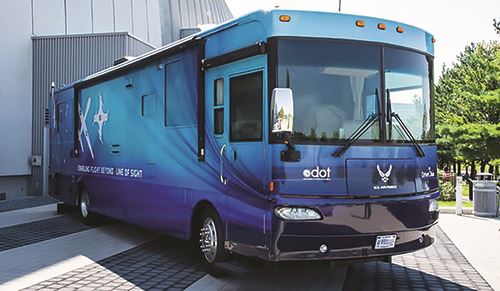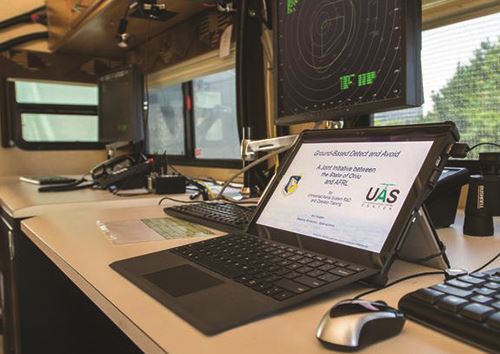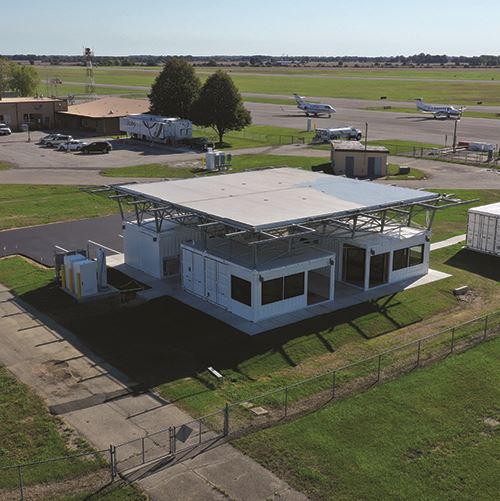Springfield–Beckley Municipal Airport (SGH), located between Dayton and Columbus, has become one of the hottest spots in the United States for testing and flight of advanced air mobility aircraft. Unmanned drones and electric vertical takeoff/landing (eVTOL) aircraft are just two types of systems currently sharing the airspace above SGH. And an $8.2 million project is in the works to accommodate even more innovation.
In 1903, aviation first took flight in Dayton, OH, under the wings of an aircraft built by the Wright Brothers. Who could have predicted that more than 115 years later, the future of aviation would be taking off just 30 miles from their hometown?
Springfield–Beckley Municipal Airport (SGH), located between Dayton and Columbus, has become one of the hottest spots in the United States for testing and flight of advanced air mobility aircraft. Unmanned drones and electric vertical takeoff/landing (eVTOL) aircraft are just two types of systems currently sharing the airspace above SGH. And an $8.2 million project is in the works to accommodate even more innovation.
Southwestern Ohio may seem an unlikely spot for a testing site for advanced unmanned aircraft systems, but SGH’s location, infrastructure and relationships—not to mention its willingness to take a risk—have helped harness a unique opportunity.
|
Project: Testing & Flights of Advanced Air Mobility Aircraft Location: Springfield-Beckley (OH) Municipal Airport Under Construction: National Advanced Air Mobility Center of Excellence Key Components: 30,000 sq. ft. of office space; 15,000 sq. ft. of hangar space Purpose: Provide collaborative place for cutting-edge research, development & flight testing of advanced air mobility technology aligned with the U.S. Air Force, Air Force Research Labs, AFWERX (Agility Prime), private industry & academia Cost: $8.2 million Funding: $6 million from Dept. of Defense – Defense Community Infrastructure Program; $2 million from JobsOhio; $200,000 from city of Springfield, OH Timeline: Design & engineering currently underway; construction scheduled for July 1, 2022-June 30, 2023 Project Partners: Marker Construction; MSA Design; Woolpert; Ohio UAS Center; Dayton Development Coalition; JobsOhio Key FAA Permissions Needed: 7460-1 Notice of Proposed Construction or Alteration, Airport Environmental Review Process (NEPA) Entities Using the Airfield for Testing & Flights: BETA; Joby; Kittyhawk; LIFT Aircraft; Air Force Research Labs; OH Dept. of Transportation; Ohio UAS Center; SelectTech GeoSpatial; local & state universities; multiple UAS companies & start-ups; multiple eVTOL companies & start-ups; equipment manufacturers & suppliers related to UAS & eVTOL markets |
At an Inflection Point
The opportunity started in 2005, when the Ohio Air National Guard (OANG) Base’s 178th Fighter Wing, which is stationed at SGH, lost its F-16 training mission due to the Base Realignment and Closure Act. In its place, the OANG was assigned an intelligence mission and a new remotely piloted mission, flying the MQ-1 Predator (drone). The Predators are flown remotely and controlled from SGH.
Around the same time, the Air Force Research Labs (AFRL), based at Wright-Patterson Air Force Base just 10 minutes west of the airport, was charged with expediting the development of unmanned flight technology. As a result, it was looking for an unmanned aircraft systems (UAS) testing site closer to home so it could save the time and expense of sending pilots to other areas of the country for flight training and test flights.
Tom Franzen, Springfield assistant city manager and director of economic development, considers those two military changes key triggers in leading SGH to investigate the potential opportunities of supporting advanced air mobility (AAM).
“We were kind of at an inflection point trying to determine what kind of value we could provide to the base to try and get future missions,” says Franzen. That’s when the city of Springfield started exploring opportunities with the Dayton Development Coalition, a regional economic development agency that is part of the JobsOhio Network.
When the AFRL and Dayton Development Coalition conducted a study to identify airspace that was best suited for flying unmanned systems, it found what it was looking for right in its own backyard. SGH had the needed airspace and infrastructure. Now it needed a plan.
The airport hired Woolpert, an architecture, engineering and geospatial firm, to help bring its UAS test capabilities to life. Zachary Shuman, aviation program director at Woolpert, notes that as the firm worked on SGH’s master plan, airport management quickly transitioned from addressing AAM as a topic of consideration to taking strategic action to support its growth. “That’s why they’re where they are at today,” Shuman says, adding that the small Ohio airport may be one of the leading AAM research hubs in the country and possibly the world.
Attracting AAM to Springfield
In 2019, the FAA approved a certificate of authorization that designated a 225-square-mile airspace above the airport, from 1,000 up to 10,000 feet, as a testing site for beyond visual line of sight (BVLOS) flight. To help keep the airspace safe, the state of Ohio and AFRL collectively contributed $5 million to develop a ground-based detect-and-avoidance radar system called SkyVision. It is housed in a converted bus that operates from the middle of SGH’s airfield. The Ohio UAS Center, an entity within Ohio’s Department of Transportation, is charged with operating the SkyVision asset.
The radar system was an essential step, because to make future unmanned flights viable for air taxis, package delivery, organ transplant delivery and other missions, aircraft must be able to safely fly long distances without visual observers monitoring them from the ground or chase planes in the air. The SkyVision technology makes that possible at SGH by using existing FAA radar feeds for the area to control unmanned aircraft.

A radar system housed in this converted bus provides crucial detection and avoidance information for flight operations.

SkyVision and the unique BLOVS airspace put a spotlight on the airport that is helping attract some of the biggest players in the AAM industry to Springfield, OH.
In 2020, Agility Prime entered the picture. It works with private industry, as well as universities and research centers across the country, to accelerate the commercial market for AAM aircraft and create a domestic supply chain to support its development and production.
Its program is now under the purview of the Air Force Research Labs and is headquartered at Wright-Patterson Air Force Base. That puts SGH in a prime position to offer facilities for companies that want to test UAS. The Ohio UAS Center has been helping facilitate those connections, serving as a portal for those interested in using the testing range and SkyVision.
BETA Technologies and Joby Aviation, two top leaders in the AAM industry, have both placed their advanced flight simulators at the airport. BETA also has built an elevated charging station with two conference rooms, two offices and a power distribution unit. It also installed an electric charging station for ground vehicles at SGH.

In partnership with BETA Technologies, SGH added electric charging stations that allow electric airplanes and eVTOL systems to charge right on its ramp. A $226,000 grant from JobsOhio helped SGH become one of the first U.S. airports to add airside electric charging stations.
Kittyhawk, owned by Google co-founder Larry Page, and LIFT Aircraft are two other private industry leaders that have utilized SGH for flight testing. Both are exploring a single-seat aircraft that could be used for personal trips or expediting organ delivery.
 As airport manager, Seth Timmerman is excited about the interest SGH’s venture is drawing. “Kittyhawk came here from California to do their testing,” he notes. “That just shows how unique and how special our airspace is compared
As airport manager, Seth Timmerman is excited about the interest SGH’s venture is drawing. “Kittyhawk came here from California to do their testing,” he notes. “That just shows how unique and how special our airspace is compared
to others. It really sets us apart from everyone else.”
Shuman is similarly enthusiastic about the benefits for SGH and other general aviation facilities. “It broadens the appetite for the airport,” he explains. “There’s not only research and development activity going on. There are also economic development opportunities, and there are infrastructure development and improvement opportunities that wouldn’t have been presented otherwise.”
He adds that AAM also provides new onramps for people who traditionally would not get involved in general aviation or small aircraft. “I think that advanced air mobility truly has an opportunity to revolutionize the way people think about aviation, and specifically, the way they think about the benefit of general aviation airports that are proliferating around communities completely under the radar,” Shuman says.
Timmerman is already seeing the associated benefits. “It’s obviously huge for the community overall,” he says. “It brings us national attention and puts Springfield on the map. It’s bringing all these people to our airport to notice what it has to provide.”

Building the Plane While Flying It
One of the biggest challenges SGH is encountering while developing its UAS test facilities is that the technology innovators are outpacing the regulators. Shuman notes that there was a lot of back and forth between the FAA and local stakeholders during planning. “This is new, and Springfield is one of the first airports to do it on this scale,” he explains. “Naturally, there was some pause by people who should be calling a timeout to ensure that things are done safely in accordance with statutes and regulations to provide guidance for an airport that is largely publicly funded.”

That said, Shuman reports that the FAA worked really hard not to slow down the process while still ensuring safety and protection.
Franzen adds that the city is excited about the role SGH is playing to help inform the discussions around AAM regulations. “The opportunity that’s happening here, specifically with BETA installing their electric recharging stations, is going to give the FAA and us an opportunity to look at how these things can be safely integrated into the airspace around the country,” he remarks. “We’re working hand-in-hand with the FAA and industry partners as they develop rules and guidance for these kinds of systems.”
Continued Collaboration
Next up for development at SGH is the National Advanced Air Mobility Center of Excellence; and the airport received a $6 million grant from the Department of Defense to help build it. Airport leaders expect to break ground on the project this July and open the center for operation in June 2023.
The new facility—a 30,000-square foot office building and a 15,000-square-foot hangar—will be a place for collaboration between private-industry companies like Joby, BETA, Kittyhawk and Lift. “It will provide office space and support for them while they’re utilizing the test range, having customers come to fly the flight simulators or to see flight tests,” Franzen says.
Companies using the center also will be able to work side-by-side with personnel from the Air Force Research Labs, Wright-Patterson Air Force Base, and research institutions such as The Ohio State University, University of Cincinnati and the University of Dayton Research Institute.

Could AAM Work at Your Airport?
By most accounts, AAM is the next big thing in aviation. So how can other airports cash in on related opportunities? And should they?
Shuman says that often the biggest hurdle is simply seeing AAM as an option. “General aviation airports, the size of Springfield, don’t have large staffs; they don’t have a lot of time or money to start planning and thinking about these things,” he says. “But it’s important, and they shouldn’t miss it.”
That said, he admits AAM isn’t for everyone. He also acknowledges that it takes a fair amount of consideration to determine whether this sector is something an airport could or should pursue. Shuman urges airport leaders to make informed decisions about whether AAM would benefit their facilities and community, or if it is something that might negatively impact operations.
But it’s not an all-or-nothing proposition, and he predicts that the next few years will likely offer a variety of opportunities in all shapes and sizes.
“You might not be building a terminal and starting a high-tempo operation,” says Shuman. “But there are research and manufacturing opportunities; there are unique rural cargo and essential air service opportunities that just never would have been thought of before.”
He advises airport executives to work with their FBOs, evaluate their infrastructure and study whether their airport is designed to accommodate AAM operations.
In terms of infrastructure, Franzen believes that one of the initial drivers is meeting the need for eVTOL charging systems. “Airports are going to have to plan for and understand how they’re going to accommodate those recharging needs,” he says. “Then you can talk about airspace and all the other issues.”
Into the Future
Thanks to the investments Springfield is making, Shuman predicts increased desire from new tenants that want to bring both temporary and permanent facilities to the airport.
And SGH is ready.
Timmerman thinks the small airport is poised perfectly to make a big difference in the future of AAM. “You can either be at the leading edge, or you can be the follower,” he says. “Being at the forefront of the technology, we’re seeing it first, and we can hopefully harvest that energy.”
With that in mind, SGH intends to go beyond the testing and development currently happening at its airfield. “Our long-term goal is to catch that manufacturing and bring it to Springfield,” Timmerman explains. “That is going to not only create jobs, but growth for the airport, growth for the community, and overall create good for the country.”
Being on the leading edge of aviation reminds Timmerman of the area’s historical roots. “We’re the birthplace of aviation,” he reflects. “So I feel like this is kind of the next Wright Brothers segment. Aviation went from piston aircraft to the jet phase, and electric aviation is the third phase we’re looking at now. We’re going try to keep that aviation tradition in Ohio and keep it rolling.”


 facts&figures
facts&figures

